Assessment of Energy Use Based on an Implementation of IoT, Cloud Systems, and Artificial Intelligence
Abstract
1. Introduction
- Interconnection: The ability of machines, devices, sensors, and people to connect and communicate with each other through the Internet of Things (IoT) or Internet of People (IoP).
- Transparency of information: The transparency offered by Industry 4.0 technology provides operators with a wealth of useful information needed to make the right decisions.
- Technical assistance: First, the ability of maintain systems to support people by aggregating and visualizing information comprehensively to make informed decisions and resolve urgent issues in a short time. Second, the ability of physical cybernetic systems to physically support people by performing a series of unpleasant, too strenuous, or unsafe tasks for their human counterpart.
- Decentralized decisions: The ability of physical cybernetic systems to make decisions on their own and to perform their tasks as autonomously as possible. Only in case of exceptions, interferences or conflicting objectives, tasks are delegated to a higher level.
- Cyber–physical systems;
- Internet of things;
- Cloud computing;
- Cognitive computing.
2. Materials and Methods
- Photovoltaic system (4 photovoltaic panels) for a total power of approximately 1 kWp;
- Pack with 4 batteries 240 Ah @ 12V, 5 h autonomy (42.8 A at 10.2 Volts);
- Electrical control panel and system management (HyREI).
3. Results
3.1. Product Monitoring and Analysis of a Hybrid Power System
3.2. Data Testing and Analysis from Electrical Appliances and Systems
3.3. Data Analysis and Prediction Examples Using the Poket Platform
4. Discussion
Author Contributions
Funding
Institutional Review Board Statement
Informed Consent Statement
Data Availability Statement
Conflicts of Interest
References
- Zarnescu, A.; Ungurelu, R.; Secere, M.; Coman, C.M.; Varzaru, G. Putting Internet-Of-Things at the Service of Sustainable Agriculture. Case Study: Sysagria. Lucr. Ştiinţifice 2019, 62, 9–14. [Google Scholar]
- Bhuiyan, M.Z.A.; Wang, G.; Cao, J.; Wu, J. Deploying Wireless Sensor Networks with Fault-Tolerance for Structural Health Monitoring. IEEE Trans. Comput. 2015, 64, 382–395. [Google Scholar] [CrossRef]
- Coman, C.M.; Florescu, A.; Stigliano, G. Distributed Sensors Array for Composite Materials Manufacturing Quality Assurance. In Proceedings of the 2019 11th International Symposium on Advanced Topics in Electrical Engineering (ATEE), Bucharest, Romania, 28–30 March 2019; IEEE: Piscataway, NJ, USA, 2019; pp. 1–6. [Google Scholar]
- Dubey, K.; Shams, M.Y.; Sharma, S.C.; Alarifi, A.; Amoon, M.; Nasr, A.A. A Management System for Servicing Multi-Organizations on Community Cloud Model in Secure Cloud Environment. IEEE Access 2019, 7, 159535–159546. [Google Scholar] [CrossRef]
- Romero, C.A.T.; Castro, D.F.; Ortiz, J.H.; Khalaf, O.I.; Vargas, M.A. Synergy between Circular Economy and Industry 4.0: A Literature Review. Sustainability 2021, 13, 4331. [Google Scholar] [CrossRef]
- Almada-Lobo, F. The Industry 4.0 Revolution and the Future of Manufacturing Execution Systems (MES). J. Innov. Manag. 2016, 3, 16–21. [Google Scholar] [CrossRef]
- Qi, L.; Hu, C.; Zhang, X.; Khosravi, M.R.; Sharma, S.; Pang, S.; Wang, T. Privacy-Aware Data Fusion and Prediction with Spatial-Temporal Context for Smart City Industrial Environment. IEEE Trans. Ind. Inf. 2021, 17, 4159–4167. [Google Scholar] [CrossRef]
- Maktedar, P.P.; Deshpande, V.S. Interpretation of Reliability in Wireless Sensor Networks. In Proceedings of the 2013 International Conference on Cloud & Ubiquitous Computing & Emerging Technologies, Pune, India, 15 November 2013; IEEE Xplore: Piscataway, NJ, USA, 2013. [Google Scholar]
- Misra, S.; Chatterjee, S.; Obaidat, M.S. On Theoretical Modeling of Sensor Cloud: A Paradigm Shift from Wireless Sensor Network. IEEE Syst. J. 2017, 11, 1084–1093. [Google Scholar] [CrossRef]
- Fernandes, J.; Reis, J.; Melão, N.; Teixeira, L.; Amorim, M. The Role of Industry 4.0 and BPMN in the Arise of Condition-Based and Predictive Maintenance: A Case Study in the Automotive Industry. Appl. Sci. 2021, 11, 3438. [Google Scholar] [CrossRef]
- Stodt, J.; Schönle, D.; Reich, C.; Ghovanlooy Ghajar, F.; Welte, D.; Sikora, A. Security Audit of a Blockchain-Based Industrial Application Platform. Algorithms 2021, 14, 121. [Google Scholar] [CrossRef]
- Florea, B.C.; Taralunga, D.D. Blockchain IoT for Smart Electric Vehicles Battery Management. Sustainability 2020, 12, 3984. [Google Scholar] [CrossRef]
- Florea, B.C. Blockchain and Internet of Things Data Provider for Smart Applications. In Proceedings of the 2018 7th Mediterranean Conference on Embedded Computing (MECO), Budva, Montenegro, 7–10 June 2018; IEEE: Piscataway, NJ, USA, 2008; pp. 1–4. [Google Scholar]
- Martín-Gómez, A.; Ávila-Gutiérrez, M.J.; Aguayo-González, F. Holonic Reengineering to Foster Sustainable Cyber-Physical Systems Design in Cognitive Manufacturing. Appl. Sci. 2021, 11, 2941. [Google Scholar] [CrossRef]
- Sahal, R.; Alsamhi, S.H.; Breslin, J.G.; Brown, K.N.; Ali, M.I. Digital Twins Collaboration for Automatic Erratic Operational Data Detection in Industry 4.0. Appl. Sci. 2021, 11, 3186. [Google Scholar] [CrossRef]
- Coman, C.M.; Florescu, A.; Oancea, C.D. Improving the Efficiency and Sustainability of Power Systems Using Distributed Power Factor Correction Methods. Sustainability 2020, 12, 3134. [Google Scholar] [CrossRef]
- Coman, C.M.; Florescu, A. Electric Grid Monitoring and Control Architecture for Industry 4.0 Systems. In Proceedings of the 2018 International Symposium on Fundamentals of Electrical Engineering (ISFEE), Bucharest, Romania, 1–3 November 2018; IEEE: Piscataway, NJ, USA, 2008; pp. 1–6. [Google Scholar]
- Serrano-Magaña, H.; González-Potes, A.; Ibarra-Junquera, V.; Balbastre, P.; Martínez-Castro, D.; Simó, J. Software Components for Smart Industry Based on Microservices: A Case Study in pH Control Process for the Beverage Industry. Electronics 2021, 10, 763. [Google Scholar] [CrossRef]
- Skarlat, O.; Schulte, S.; Borkowski, M.; Leitner, P. Resource Provisioning for IoT Services in the Fog. In Proceedings of the 2016 IEEE 9th International Conference on Service-Oriented Computing and Applications (SOCA), Macau, China, 4–6 November 2016; IEEE: Piscataway, NJ, USA, 2016; pp. 32–39. [Google Scholar]
- Desai, P.; Sheth, A.; Anantharam, P. Semantic Gateway as a Service Architecture for IoT Interoperability. In Proceedings of the 2015 IEEE International Conference on Mobile Services, New York, NY, USA, 27 July 2015; IEEE: Piscataway, NJ, USA, 2008. [Google Scholar]
- Cotet, G.B.; Carutasu, N.L.; Chiscop, F. Industry 4.0 Diagnosis from an IMillennial Educational Perspective. Educ. Sci. 2020, 10, 21. [Google Scholar] [CrossRef]
- Botlíková, M.; Botlík, J. Local Extremes of Selected Industry 4.0 Indicators in the European Space—Structure for Autonomous Systems. J. Risk Financ. Manag. 2020, 13, 13. [Google Scholar] [CrossRef]
- Dastjerdi, A.V.; Gupta, H.; Calheiros, R.N.; Ghosh, S.K.; Buyya, R. Fog Computing: Principles, architectures, and applications. In Internet of Things; Elsevier: Amsterdam, The Netherlands, 2016; pp. 61–75. ISBN 9780128053959. [Google Scholar]
- Jung, H.; Jeon, J.; Choi, D.; Park, J.-Y. Application of Machine Learning Techniques in Injection Molding Quality Prediction: Implications on Sustainable Manufacturing Industry. Sustainability 2021, 13, 4120. [Google Scholar] [CrossRef]
- Stanisławski, R.; Szymonik, A. Impact of Selected Intelligent Systems in Logistics on the Creation of a Sustainable Market Position of Manufacturing Companies in Poland in the Context of Industry 4.0. Sustainability 2021, 13, 3996. [Google Scholar] [CrossRef]
- Santos, G.L.; Endo, P.T.; Sadok, D.; Kelner, J. When 5G Meets Deep Learning: A Systematic Review. Algorithms 2020, 13, 208. [Google Scholar] [CrossRef]
- Muntjir, M.; Rahul, M.; Alhumyani, H. An Analysis of Internet of Things (IoT): Novel Architectures, Modern Applications, Security Aspects and Future Scope with Latest Case Studies. Int. J. Eng. Res. Technol. 2017, 6, 422–447. [Google Scholar]
- González, C.; Fernández-León, J. A Machine Learning Model to Detect Flow Disturbances during Manufacturing of Composites by Liquid Moulding. J. Compos. Sci. 2020, 4, 71. [Google Scholar] [CrossRef]
- Ardanza, A.; Moreno, A.; Segura, Á.; de la Cruz, M.; Aguinaga, D. Sustainable and Flexible Industrial Human Machine Interfaces to Support Adaptable Applications in the Industry 4.0 Paradigm. Int. J. Prod. Res. 2019, 57, 4045–4059. [Google Scholar] [CrossRef]
- Li, X.; Niu, J.; Bhuiyan, M.Z.A.; Wu, F.; Karuppiah, M.; Kumari, S. A Robust ECC-Based Provable Secure Authentication Protocol with Privacy Preserving for Industrial Internet of Things. IEEE Trans. Ind. Inf. 2018, 14, 3599–3609. [Google Scholar] [CrossRef]
- Miettinen, M.; Nguyen, T.D.; Sadeghi, A.-R.; Asokan, N. Revisiting Context-Based Authentication in IoT. In Proceedings of the DAC ’18: Proceedings of the 55th Annual Design Automation Conference, San Francisco, CA, USA, 24–29 June 2018; pp. 1–6. [Google Scholar]
- Rajamani, P.K.; Ageyeva, T.; Kovács, J.G. Personalized Mass Production by Hybridization of Additive Manufacturing and Injection Molding. Polymers 2021, 13, 309. [Google Scholar] [CrossRef] [PubMed]
- Nur-A-Alam; Ahsan, M.; Based, M.A.; Haider, J.; Rodrigues, E.M.G. Smart Monitoring and Controlling of Appliances Using LoRa Based IoT System. Designs 2021, 5, 17. [Google Scholar] [CrossRef]
- Pech, M.; Vrchota, J.; Bednář, J. Predictive Maintenance and Intelligent Sensors in Smart Factory: Review. Sensors 2021, 21, 1470. [Google Scholar] [CrossRef] [PubMed]
- Hollowell, J.C.; Kollar, B.; Vrbka, J.; Kovalova, E. Cognitive Decision-Making Algorithms for Sustainable Manufacturing Processes in Industry 4.0: Networked, Smart, and Responsive Devices. Econ. Manag. Financ. Mark. 2019, 14, 9. [Google Scholar] [CrossRef][Green Version]
- Gröger, C. Building an Industry 4.0 Analytics Platform: Practical Challenges, Approaches and Future Research Directions. Datenbank Spektrum 2018, 18, 5–14. [Google Scholar] [CrossRef]
- Sturari, M.; Liciotti, D.; Pierdicca, R.; Frontoni, E.; Mancini, A.; Contigiani, M.; Zingaretti, P. Robust and Affordable Retail Customer Profiling by Vision and Radio Beacon Sensor Fusion. Pattern Recognit. Lett. 2016, 81, 30–40. [Google Scholar] [CrossRef]
- Stark, E.; Kučera, E.; Haffner, O.; Drahoš, P.; Leskovský, R. Using Augmented Reality and Internet of Things for Control and Monitoring of Mechatronic Devices. Electronics 2020, 9, 1272. [Google Scholar] [CrossRef]
- Ooi, B.Y.; Beh, W.L.; Lee, W.-K.; Shirmohammadi, S. Using the Cloud to Improve Sensor Availability and Reliability in Remote Monitoring. IEEE Trans. Instrum. Meas. 2019, 68, 1522–1532. [Google Scholar] [CrossRef]
- Mukherjee, M.; Shu, L.; Wang, D. Survey of Fog Computing: Fundamental, Network Applications, and Research Challenges. IEEE Commun. Surv. Tutor. 2018, 20, 1826–1857. [Google Scholar] [CrossRef]
- Pozdnyakova, U.A.; Golikov, V.V.; Peters, I.A.; Morozova, I.A. Genesis of the Revolutionary Transition to Industry 4.0 in the 21st Century and Overview of Previous Industrial Revolutions. In Industry 4.0: Industrial Revolution of the 21st Century; Popkova, E.G., Ragulina, Y.V., Bogoviz, A.V., Eds.; Springer International Publishing: Cham, Switzerland, 2019; Volume 169, pp. 11–19. ISBN 9783319943091. [Google Scholar]
- Jurado Pérez, L.; Salvachúa, J. Simulation of Scalability in Cloud-Based IoT Reactive Systems Leveraged on a WSAN Simulator and Cloud Computing Technologies. Appl. Sci. 2021, 11, 1804. [Google Scholar] [CrossRef]
- Fan, Y.; Zou, R.; Fan, X.; Dong, R.; Xie, M. A Hierarchical Clustering Method to Repair Gaps in Point Clouds of Powerline Corridor for Powerline Extraction. Remote Sens. 2021, 13, 1502. [Google Scholar] [CrossRef]
- Valdez, F.; Castillo, O.; Melin, P. Bio-Inspired Algorithms and Its Applications for Optimization in Fuzzy Clustering. Algorithms 2021, 14, 122. [Google Scholar] [CrossRef]
- Wu, J. Advances in K-Means Clustering; Springer Theses; Springer: Berlin/Heidelberg, Germany, 2012; ISBN 9783642298066. [Google Scholar]
- Coman, C.M.; D’amico, G.; Coman, A.V.; Florescu, A. Techniques to Improve Reliability in an IoT Architecture Framework for Intelligent Products. IEEE Access 2021, 9, 56940–56954. [Google Scholar] [CrossRef]
- Kelly, J.; Knottenbelt, W. The UK-DALE Dataset, Domestic Appliance-Level Electricity Demand and Whole-House Demand from Five UK Homes. Sci. Data 2015, 2, 150007. [Google Scholar] [CrossRef] [PubMed]
- Ridi, A.; Gisler, C.; Hennebert, J. ACS-F2–A New Database of Appliance Consumption Signatures. In Proceedings of the 2014 6th International Conference of Soft Computing and Pattern Recognition (SoCPaR), Tunis, Tunisia, 11–14 August 2014; IEEE: Piscataway, NJ, USA, 2014. pp. 145–150.


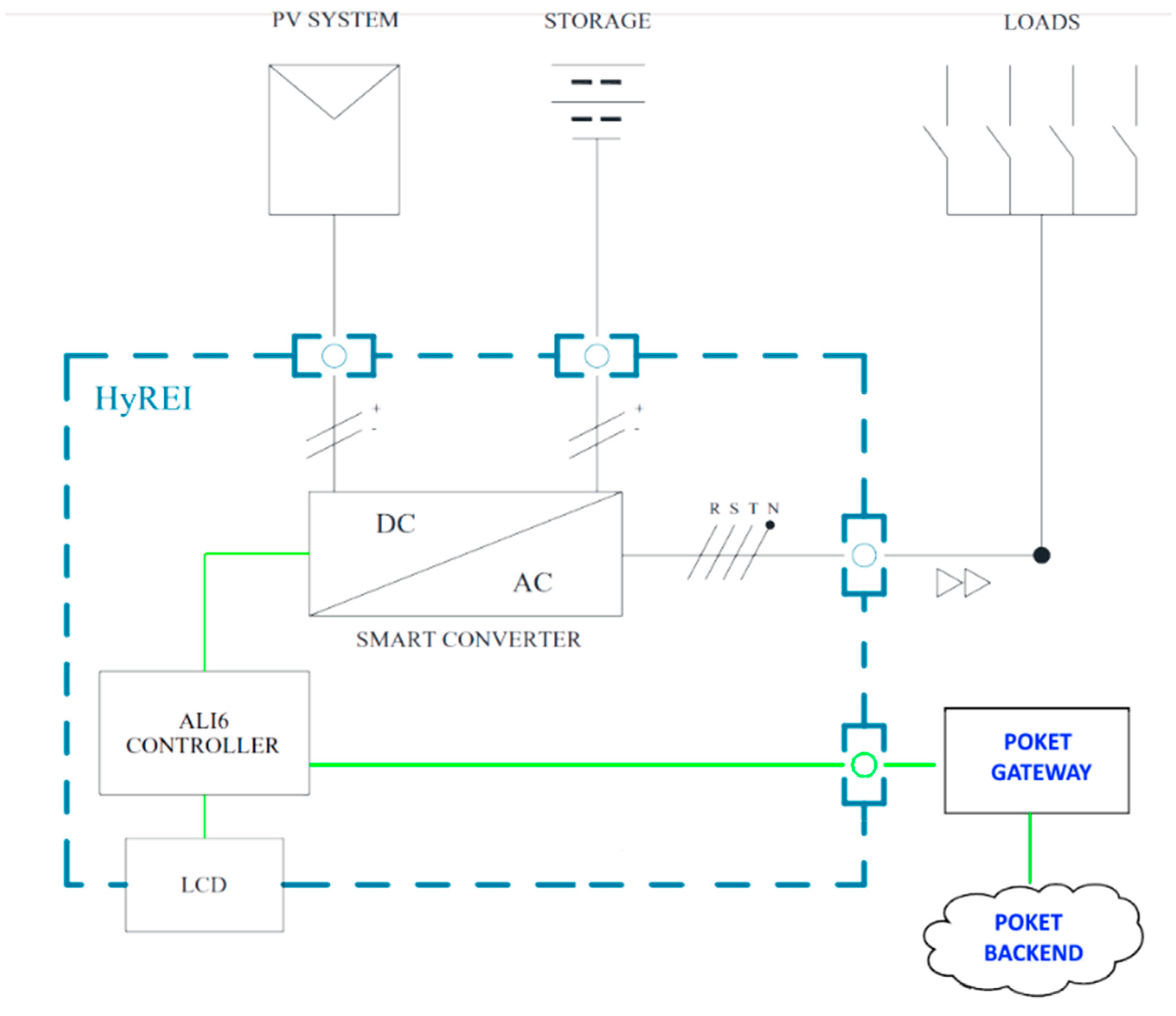
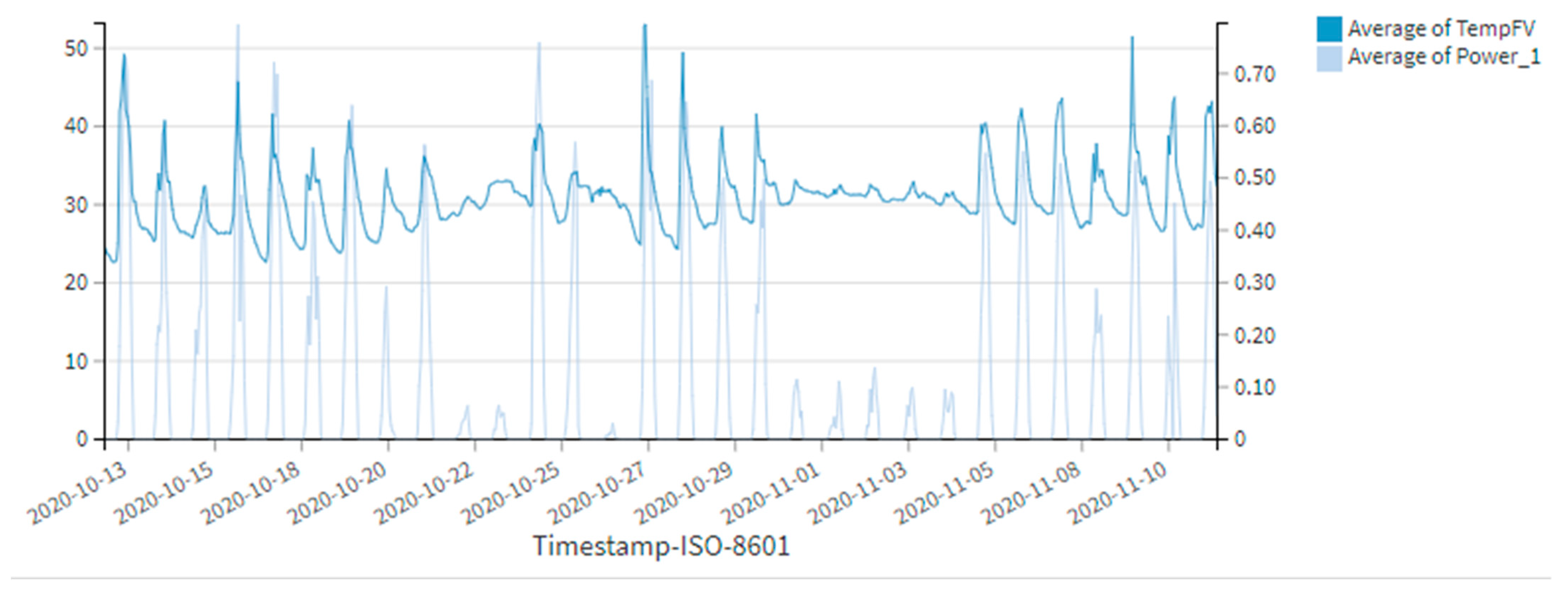

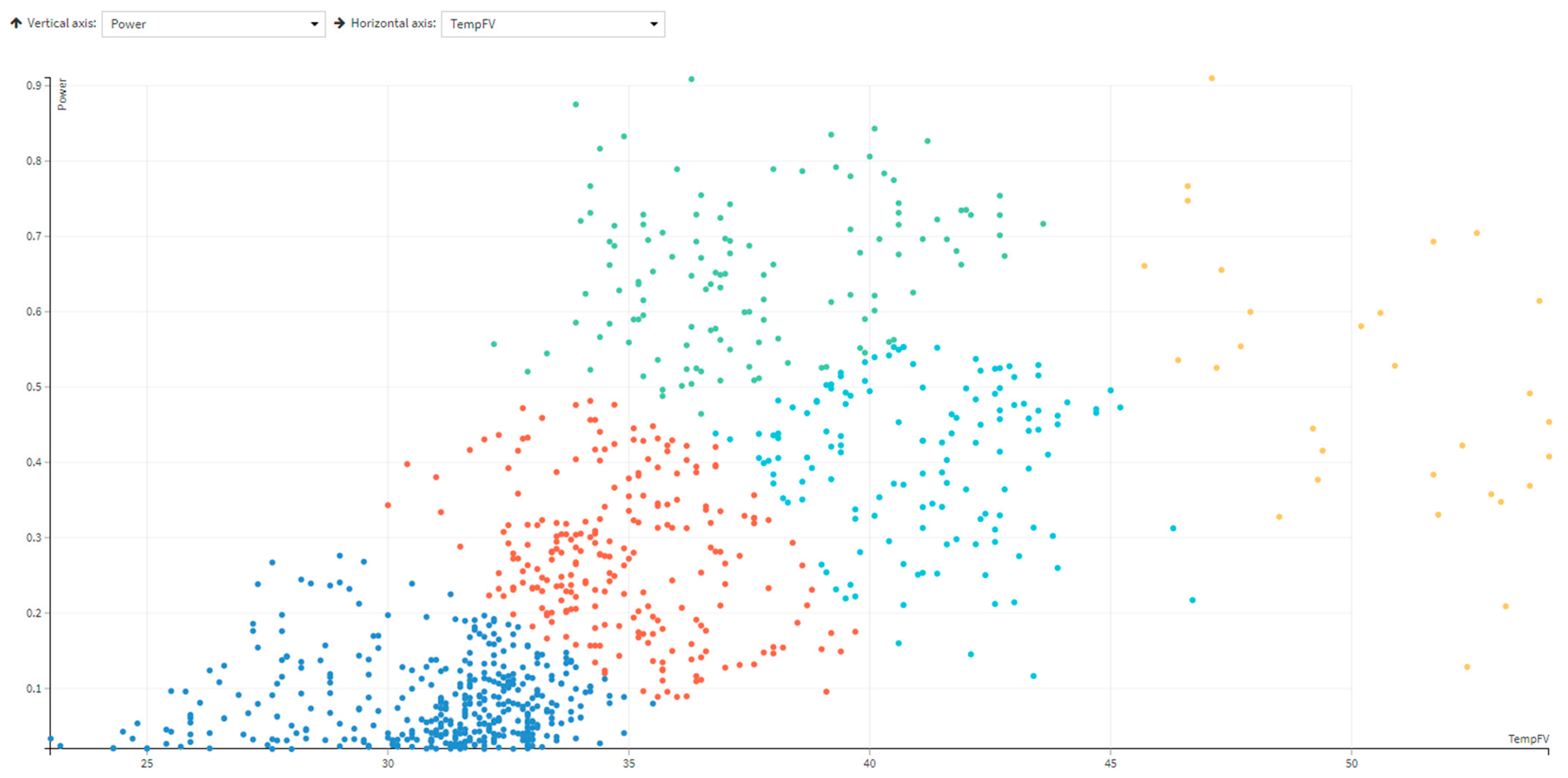

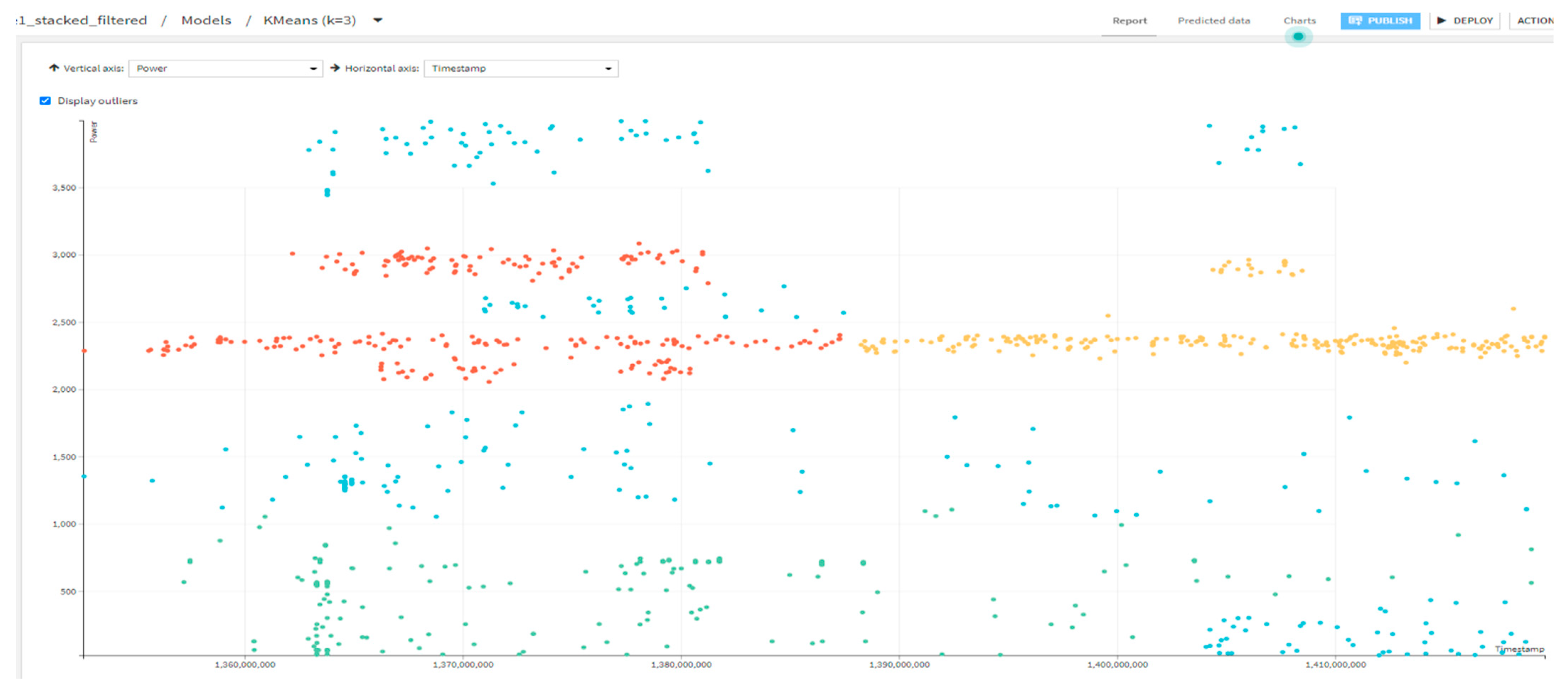
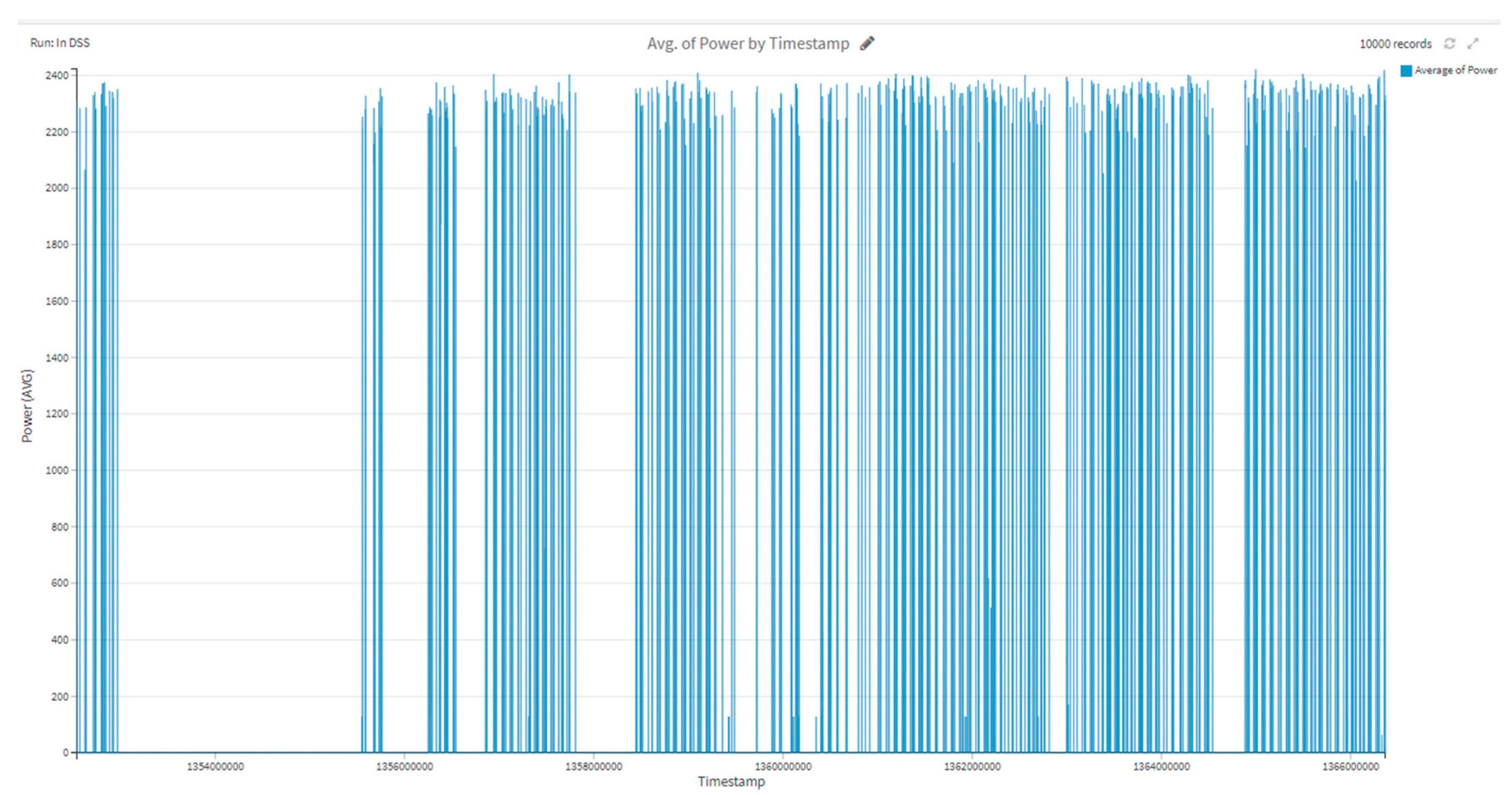
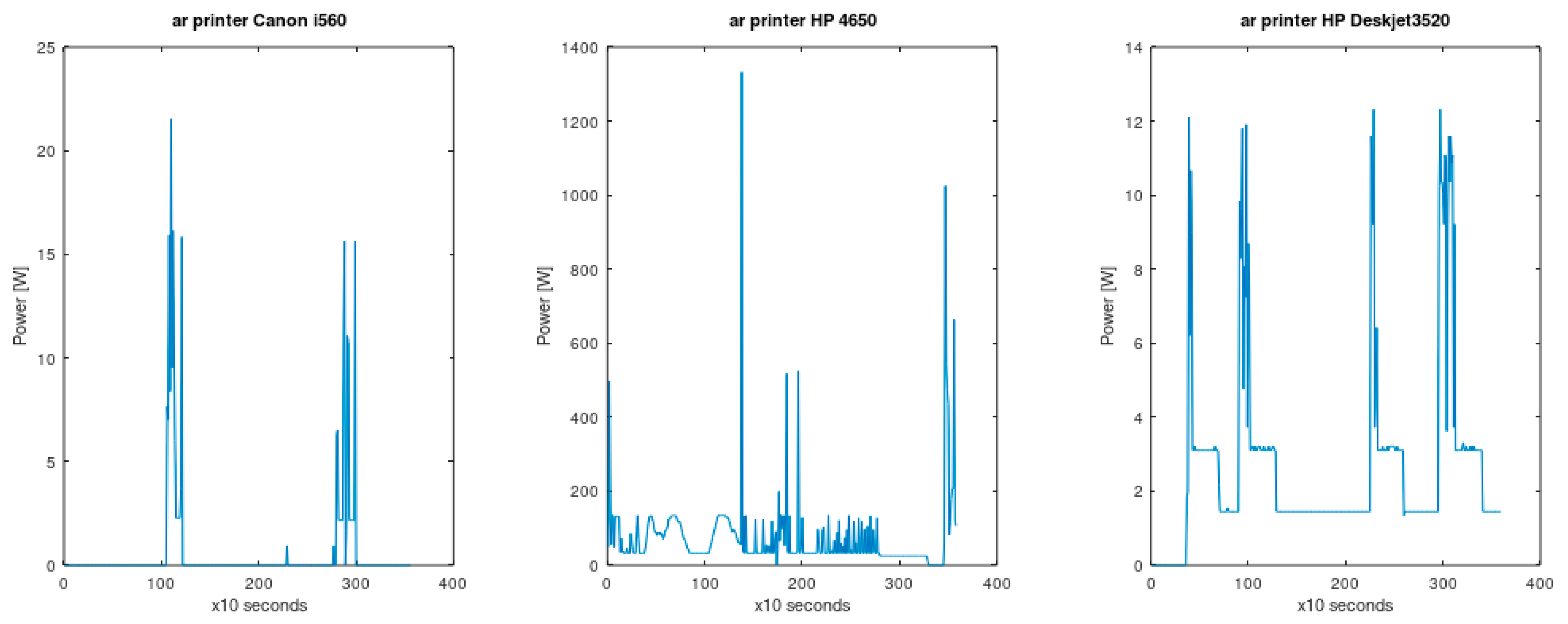
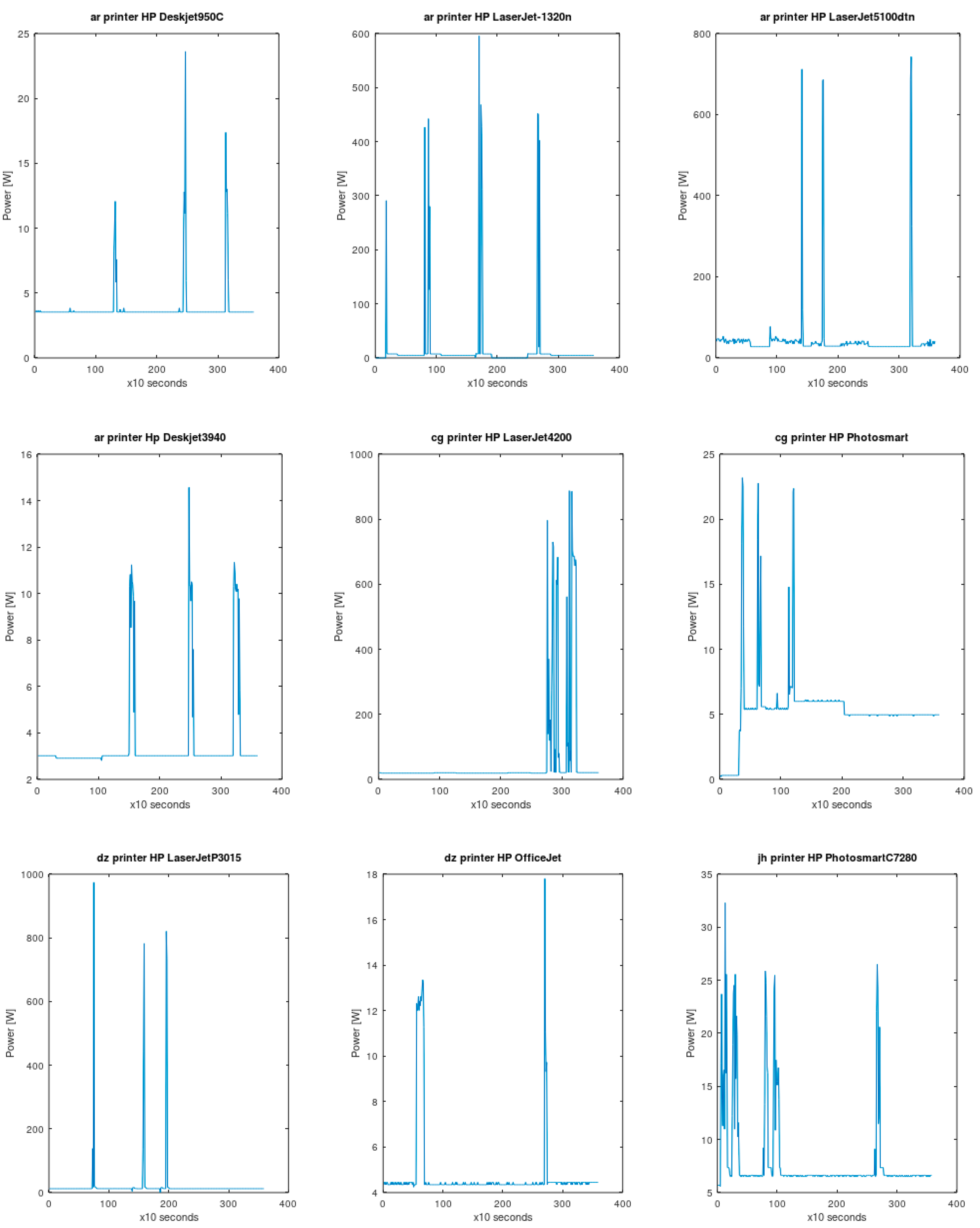



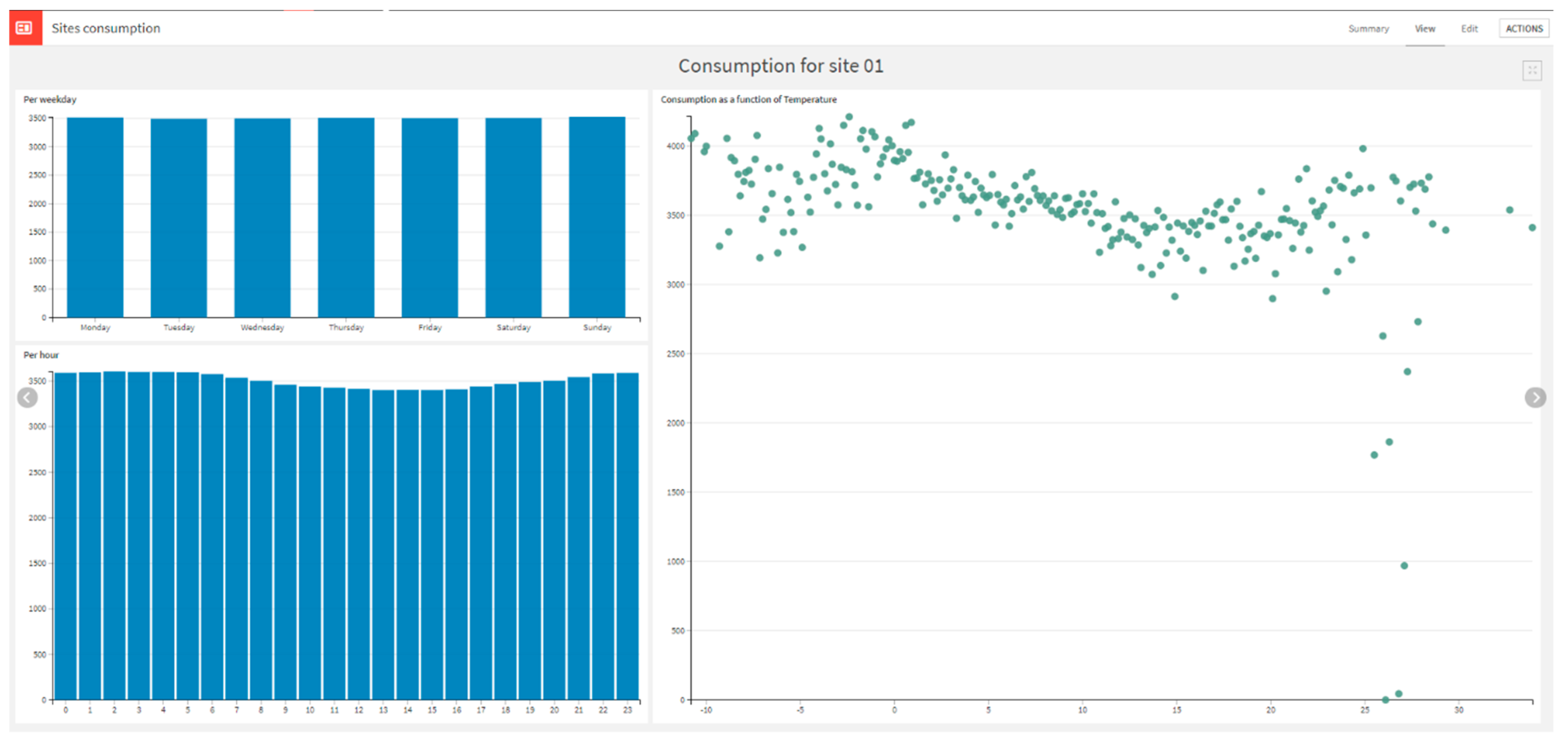

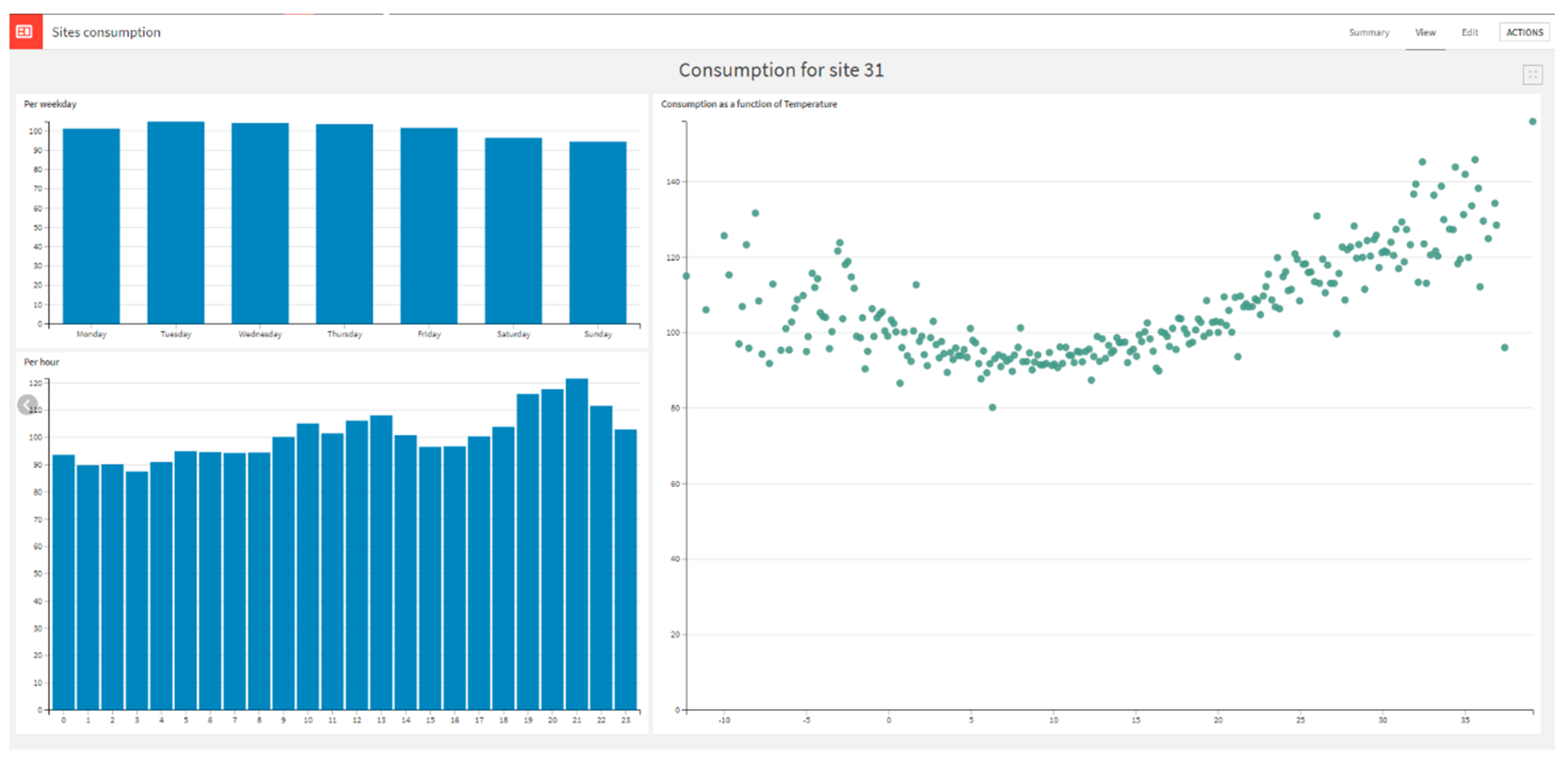
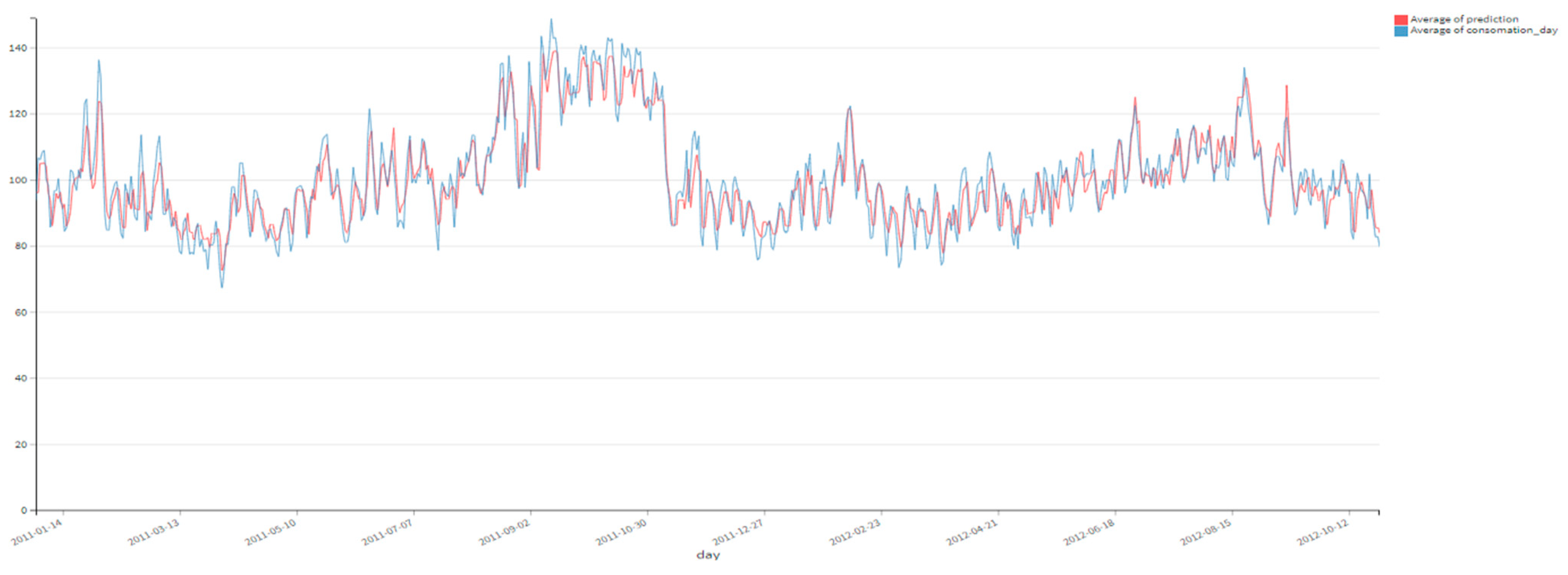
| Timestamp | Temp PV (°C) | (V) | (A) |
|---|---|---|---|
| 1605027780 | 32.0 | 235.9 | 0.006 |
| 1605026940 | 32.6 | 230.9 | 0.089 |
| 1605025980 | 32.9 | 224.2 | 0.152 |
| 1605025140 | 32.8 | 227.5 | 0.320 |
| 1605024240 | 33.7 | 230.8 | 0.520 |
| 1605023280 | 33.7 | 231.8 | 0.636 |
| 1605022380 | 33.7 | 230.5 | 0.609 |
| 1605021480 | 33.9 | 237.2 | 0.666 |
| 1605020580 | 34.2 | 237.3 | 0.660 |
| 1605019680 | 34.3 | 224.8 | 0.929 |
| 1605018780 | 34.9 | 233.7 | 0.964 |
| 1605017880 | 36.0 | 234.6 | 1.492 |
| 1605016980 | 36.0 | 229.8 | 1.676 |
| 1605016080 | 43.3 | 224.3 | 2.042 |
| 1605015180 | 43.9 | 229.5 | 2.012 |
| 1605014280 | 43.7 | 224.7 | 1.825 |
| 1605013380 | 44.1 | 224.3 | 2.138 |
| 1605008940 | 40.6 | 233.3 | 1.942 |
| 1605004380 | 36.6 | 225.7 | 0.782 |
| 1605003480 | 36.1 | 237.5 | 0.871 |
| 1605002640 | 36.4 | 224.9 | 0.850 |
| 1605001680 | 41.8 | 234.3 | 1.271 |
| 1605000780 | 42.3 | 227.6 | 1.426 |
| 1604999880 | 35.9 | 229.0 | 0.654 |
| 1604998980 | 35.5 | 222.6 | 0.774 |
| 1604998080 | 32.5 | 229.6 | 0.508 |
| 1604997180 | 31.1 | 225.6 | 0.389 |
| 1604996280 | 31.6 | 231.1 | 0.393 |
| 1604995380 | 28.0 | 234.6 | 0.218 |
| 1604994480 | 27.6 | 237.8 | 0.140 |
| 1604993580 | 27.0 | 233.3 | 0.011 |
| 1604941020 | 32.7 | 233.8 | 0.010 |
| 1604940120 | 32.6 | 226.7 | 0.058 |
| 1604939220 | 32.7 | 224.8 | 0.043 |
| 1604938320 | 33.8 | 229.5 | 0.257 |
| 1604937420 | 34.0 | 232.9 | 0.329 |
| 1604936520 | 33.8 | 232.8 | 0.371 |
| 1604935620 | 34.2 | 226.9 | 0.424 |
| 1604934720 | 34.2 | 225.6 | 0.455 |
| 1604934180 | 34.9 | 235.4 | 1.118 |
| 1604933340 | 36.3 | 232.9 | 0.682 |
| 1604932380 | 36.6 | 222.7 | 1.513 |
| 1604931480 | 36.8 | 226.7 | 1.747 |
| 1604930580 | 37.7 | 235.9 | 1.855 |
| 1604929740 | 36.5 | 227.0 | 2.045 |
| 1604928780 | 36.6 | 223.7 | 1.527 |
| 1604927880 | 36.3 | 230.9 | 2.183 |
| 1604926980 | 36.9 | 236.0 | 2.155 |
| 1604926080 | 36.9 | 226.7 | 2.481 |
| 1604925180 | 37.5 | 237.2 | 2.221 |
| 1604924280 | 37.7 | 224.1 | 2.282 |
| 1604922780 | 39.5 | 227.8 | 2.162 |
| 1604921880 | 39.5 | 233.3 | 2.046 |
| 1604920980 | 41.1 | 223.4 | 1.918 |
| 1604919780 | 41.1 | 235.2 | 1.822 |
| 1604918880 | 52.9 | 223.1 | 1.603 |
| 1604918040 | 53.7 | 224.4 | 1.643 |
| 1604917080 | 53.1 | 236.9 | 1.466 |
| 1604916180 | 46.3 | 229.9 | 1.359 |
| 1604915280 | 46.7 | 228.3 | 0.951 |
| 1604914380 | 41.1 | 233.4 | 1.085 |
| 1604913480 | 35.4 | 230.3 | 0.697 |
| 1604912580 | 34.5 | 233.1 | 0.516 |
| 1604911680 | 36.5 | 224.7 | 0.496 |
| 1604910780 | 37.6 | 222.2 | 0.594 |
| 1604909880 | 33.6 | 232.6 | 0.233 |
| 1604908980 | 29.3 | 225.8 | 0.209 |
| 1604908080 | 29.1 | 229.1 | 0.144 |
| 1604907180 | 28.7 | 234.1 | 0.003 |
Publisher’s Note: MDPI stays neutral with regard to jurisdictional claims in published maps and institutional affiliations. |
© 2021 by the authors. Licensee MDPI, Basel, Switzerland. This article is an open access article distributed under the terms and conditions of the Creative Commons Attribution (CC BY) license (https://creativecommons.org/licenses/by/4.0/).
Share and Cite
Coman, C.M.; Florescu, A.; Oancea, C.D. Assessment of Energy Use Based on an Implementation of IoT, Cloud Systems, and Artificial Intelligence. Energies 2021, 14, 3202. https://doi.org/10.3390/en14113202
Coman CM, Florescu A, Oancea CD. Assessment of Energy Use Based on an Implementation of IoT, Cloud Systems, and Artificial Intelligence. Energies. 2021; 14(11):3202. https://doi.org/10.3390/en14113202
Chicago/Turabian StyleComan, Ciprian Mihai, Adriana Florescu, and Constantin Daniel Oancea. 2021. "Assessment of Energy Use Based on an Implementation of IoT, Cloud Systems, and Artificial Intelligence" Energies 14, no. 11: 3202. https://doi.org/10.3390/en14113202
APA StyleComan, C. M., Florescu, A., & Oancea, C. D. (2021). Assessment of Energy Use Based on an Implementation of IoT, Cloud Systems, and Artificial Intelligence. Energies, 14(11), 3202. https://doi.org/10.3390/en14113202






